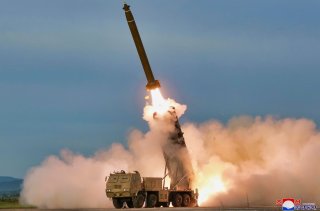Unveiling North Korea's Mighty Special Forces: Size, Structure, and Potential Threat
Despite its small size and underdevelopment, North Korea maintains a large military, including 200,000 special operations forces, a significant proportion compared to its total military size
Summary: The article discusses North Korea's global reputation as a troublemaker due to its threats and nuclear program. Despite its small size and underdevelopment, North Korea maintains a large military, including 200,000 special operations forces, a significant proportion compared to its total military size. These special forces consist of various units, including airborne, reconnaissance, light infantry, and maritime forces, with the ability to infiltrate and disrupt enemy territories. While their capabilities are acknowledged, experts debate the overall proficiency of North Korean special forces, considering the country's military standards.
North Korea Has More Weapons Besides Nukes
The Democratic People’s Republic of Korea (DPRK), known by most of the world as North Korea, has long been a troublemaker on the global stage.
With constant threats against its Southern neighbor, general saber-rattling, and a growing nuclear program, it creates constant pressure on the U.S.-led world order.
While it is a small, underdeveloped nation by nearly every metric, it nonetheless possesses one of the largest standing armies in the world, counting 1.3 million soldiers in its ranks.
Perhaps more impressive are North Korea's special operations forces, or special forces, which experts estimate at 200,000 soldiers. This may not seem like very many compared to the total size of its force, but consider that it means 15 percent of the country’s soldiers belong to the special forces as opposed to only 3 percent of the U.S. military.
North Korea's Special Forces: Organization
The Special Forces moniker usually encompasses an array of specialized units and teams. For example, Special Operations Command in the U.S. military encompasses everything from Army Green Berets who specialize in unconventional warfare such as training a partner military how best to deal with an insurgency to Navy SEALs who perform high-stakes missions like hostage rescue.
North Korea’s Special Forces also encompass several different units. Their airborne forces use old Antonov An-2 aircraft to carry out infiltration and assault missions. First introduced in 1947, this venerable craft is capable of both airdropping units as well as landing on remote stretches of highway to allow infiltration. The Reconnaissance Brigades operate similarly to the Spetsnaz of the former Soviet Union, training to infiltrate South Korea and then using direct action to attack and destroy key targets across South Korea in an attempt to cripple its economy and industry and disrupt command and control in the event of war.
Light Infantry Battalions of the DPRK are a more typical version of the Reconnaissance Brigades. These lightly armed and armored troops advance ahead of conventional forces using stealth and speed to strike behind enemy lines to disrupt communication and infiltrate rear areas. Finally, the Maritime arm of the DPRK Special Forces is thought to operate somewhere in between the Light Infantry and Reconnaissance forces, infiltrating along the coast to carry out attacks behind enemy lines. North Korea’s fleet of submarines, including 24 Romeo-class diesel boats as well as at least 45 midget submarines make an ideal platform for covertly inserting these forces.
How Good Are They?
Size isn’t the only factor on the battlefield and just because the DPRK is fielding a large number of special operators does not mean they are up to snuff. While the U.S. Department of Defense has acknowledged that “North Korean SOF personnel are among the most highly trained, well equipped, best-fed, and highly motivated forces in the KPA.” Given the state of DPRK forces, this is not a high bar to clear, however, South Korean and American planners certainly are aware of the threat these forces pose.
About the Author: Maya Carlin
Maya Carlin is an analyst with the Center for Security Policy and a former Anna Sobol Levy Fellow at IDC Herzliya in Israel. She has by-lines in many publications, including The National Interest, Jerusalem Post, and Times of Israel. You can follow her on Twitter: @MayaCarlin. You can email the Author: [email protected].
Image Credit: North Korean state media.


